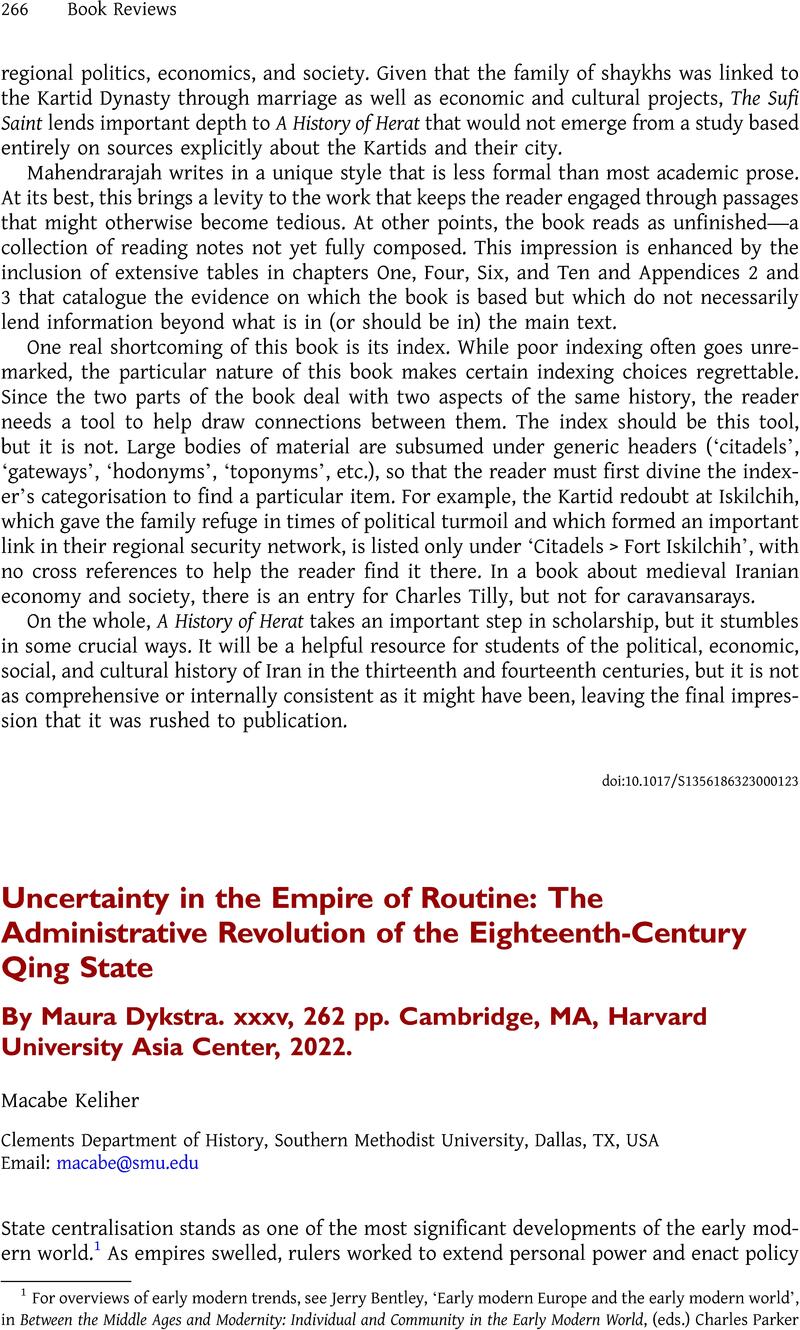No CrossRef data available.
Article contents
Uncertainty in the Empire of Routine: The Administrative Revolution of the Eighteenth-Century Qing State By Maura Dykstra. xxxv, 262 pp. Cambridge, MA, Harvard University Asia Center, 2022.
Review products
Published online by Cambridge University Press: 24 November 2023
Abstract

- Type
- Book Review
- Information
- Copyright
- Copyright © The Author(s), 2023. Published by Cambridge University Press on behalf of The Royal Asiatic Society
References
1 For overviews of early modern trends, see Bentley, Jerry, ‘Early modern Europe and the early modern world’, in Between the Middle Ages and Modernity: Individual and Community in the Early Modern World, (eds.) Charles Parker and Jerry Bentley (London, 2007), pp. 13–32Google Scholar; Clossey, Luke, ‘Early modern world’, in Berkshire Encyclopedia of World History, (eds.) William McNeill and Jerry Bentley (Berkshire, 2005), pp. 592–98Google Scholar.
2 The literature on the archival turn is large but mainly concentrated on Europe. For good overviews, see Blair, Ann, ‘Introduction’, Archival Science 10.3 (2010), pp. 195–200CrossRefGoogle Scholar; Walsham, Alexandra, ‘The social history of the archive: record-keeping in early modern Europe’, Past & Present 230.11 (2016), pp. 9–48CrossRefGoogle Scholar. Also see the Special Issues of European History Quarterly 46.3 (2016); Journal of Early Modern History, 22.5 (2018).
3 For an overview of the Qing as an early modern empire, see Evelyn Rawski, ‘The Qing formation and the early-modern period’ and R. Bin Wong, ‘Did China's late empire have an early modern era?’, both in Comparative Early Modernities, 1100–1800, (ed.) David Porter (New York, 2012), pp. 195–216.
4 An alternative conclusion that the author could draw from her claims is that the Qing was always corrupt and ineffective; the reports just brought it out into the open. It is unclear why the author does not address this alternative in the face of her claims.
5 Readers would be forgiven for turning to the body of literature on administrative revolutions, which refers to radical developments in bureaucracies and governance in the nineteenth and twentieth centuries; yet the author neither engages nor cities this literature and seems to have a far more subdued understanding of the meaning of revolution. See Riggs, Fred, ‘Modernity and bureaucracy’, Public Administration Review 57.4 (1997), pp. 347–53CrossRefGoogle Scholar.
6 Hu Kuo-tai, ‘Huangquan, guanliao, yu shehui zhixu: Qingdai Qianlongchao Zhang Hongshun xiongdi zeian yanjiu’, Zhongyang yanjiuyuan jindaishi yanjiu suo jikan (June, 1996), pp. 85–116.
7 The author frequently conflates the two types of reports without acknowledging the difference.
8 A better explanation of the aforementioned citation and the spiralling effect of more information generating more requests is the institutionalisation of norms and practices. Anxiety is neither here nor there for, when reports fell off, actors would begin to question the discrepancy as a break in the norm. This has been well theorised in organisational studies. See Hamilton, Gary and Biggart, Nicole, ‘Why people obey: theoretical observations on power and obedience in complex organizations’, Sociological Perspectives 28.1 (1985), pp. 3–28CrossRefGoogle Scholar; Trice, Harrison and Beyer, Janice, The Cultures of Work Organizations (Englewood Cliffs, NJ, 1993)Google Scholar.
9 For example, the Shilu passages that the author cites for key ‘reforms’ do not tell of pledges or the need for extensive reporting, as the author says, but rather give instructions for limited and specific situations (pp. 121–22). Similarly, a key Yongzheng-era reporting requirement for local magistrates (p. 129) turns out to have been a long-time practice, as seen in a well-known Kangxi-era handbook—so well known and important, in fact, that it has been translated into English: Huang, Liu-hung, A Complete Book Concerning Happiness and Benevolence: A Manual for Local Magistrates in Seventeenth-Century China (Tucson, 1984), pp. 617–25Google Scholar.
10 QLSL 9.12.1.4 vol. 230.
11 In a footnote, the author says that others will not be able to replicate her results because the FHA flagged her account (and these materials?) for overuse (p. 197, note 8). If I understand correctly, the author appears to have postulated non-existent evidence, blamed the archive for hiding that evidence, then announced that no one else can look for it.
12 The Shilu cannot be representative of affairs or developments for reasons stated above. In addition, any change in the frequency of appearance of any character would have to be mapped against its context as well as other characters and carried forward in time.
13 Kuhn, Philip, Soulstealers: The Chinese Sorcery Scare of 1768 (Cambridge, 1990), pp. 190–91CrossRefGoogle Scholar.





